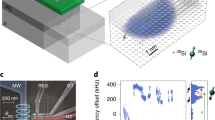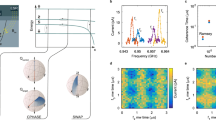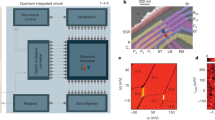Abstract
Epitaxial quantum dots (QDs) have long been identified as promising charge spin qubits offering an efficient interface to quantum light and advanced semiconductor nanofabrication technologies. However, charge spin coherence is limited by interaction with the nanoscale ensemble of atomic nuclear spins, which is particularly problematic in strained self-assembled dots. Here, we use strain-free GaAs/AlGaAs QDs, demonstrating a fully functioning two-qubit quantum register using the nanoscale ensemble of arsenic quadrupolar nuclear spins as its hardware. Tailored radio-frequency pulses allow quantum state storage for up to 20 ms, and are used for few-microsecond single-qubit and two-qubit control gates with fidelities exceeding 97%. Combining long coherence and high-fidelity control with optical initialization and readout, we implement benchmark quantum computations such as Grover’s search and the Deutsch–Jozsa algorithm. Our results identify QD nuclei as a potential quantum information resource, which can complement charge spins and light particles in future QD circuits.
This is a preview of subscription content, access via your institution
Access options
Access Nature and 54 other Nature Portfolio journals
Get Nature+, our best-value online-access subscription
$29.99 / 30 days
cancel any time
Subscribe to this journal
Receive 12 print issues and online access
$259.00 per year
only $21.58 per issue
Buy this article
- Purchase on Springer Link
- Instant access to full article PDF
Prices may be subject to local taxes which are calculated during checkout




Similar content being viewed by others
Data availability
The data that support the findings of this study are available from the corresponding authors upon reasonable request.
References
Kimble, H. J. The quantum internet. Nature 453, 1023–1030 (2008).
Kubo, Y. et al. Hybrid quantum circuit with a superconducting qubit coupled to a spin ensemble. Phys. Rev. Lett. 107, 220501 (2011).
Somaschi, N. et al. Near-optimal single-photon sources in the solid state. Nat. Photon. 10, 340–345 (2016).
Delteil, A. et al. Generation of heralded entanglement between distant hole spins. Nat. Phys. 12, 218–223 (2016).
Gangloff, D. A. et al. Quantum interface of an electron and a nuclear ensemble. Science 364, 62–66 (2019).
Wendin, G. et al. Quantum information processing with superconducting circuits: a review. Rep. Progr. Phys. 80, 106001 (2017).
Watson, T. F. et al. A programmable two-qubit quantum processor in silicon. Nature 555, 633–637 (2018).
Huang, W. et al. Fidelity benchmarks for two-qubit gates in silicon. Nature 569, 532–536 (2019).
Bechtold, A. et al. Three-stage decoherence dynamics of electron spin qubits in an optically active quantum dot. Nat. Phys. 11, 1005–1008 (2015).
Iles-Smith, J., McCutcheon, D. P. S., Nazir, A. & Mørk, J. Phonon scattering inhibits simultaneous near-unity efficiency and indistinguishability in semiconductor single-photon sources. Nat. Photon. 11, 521–526 (2017).
Urbaszek, B. et al. Nuclear spin physics in quantum dots: an optical investigation. Rev. Mod. Phys. 85, 79–133 (2013).
Taminiau, T. H., Cramer, J., van der Sar, T., Dobrovitski, V. V. & Hanson, R. Universal control and error correction in multi-qubit spin registers in diamond. Nat. Nanotechnol. 9, 171–176 (2014).
Waldherr, G. et al. Quantum error correction in a solid-state hybrid spin register. Nature 506, 204–207 (2014).
Jones, J. A., Mosca, M. & Hansen, R. H. Implementation of a quantum search algorithm on a quantum computer. Nature 393, 344–346 (1998).
Huo, Y. H. et al. A light-hole exciton in a quantum dot. Nat. Phys. 10, 46–51 (2014).
Chekhovich, E. A. et al. Measurement of the spin temperature of optically cooled nuclei and GaAs hyperfine constants in GaAs/AlGaAs quantum dots. Nat. Mater. 16, 982–986 (2017).
Waeber, A. M. et al. Pulse control protocols for preserving coherence in dipolar-coupled nuclear spin baths. Nat. Commun. 10, 3157 (2019).
Leuenberger, M. N., Loss, D., Poggio, M. & Awschalom, D. D. Quantum information processing with large nuclear spins in GaAs semiconductors. Phys. Rev. Lett. 89, 207601 (2002).
Kondo, Y. et al. Multipulse operation and optical detection of nuclear spin coherence in a GaAs/AlGaAs quantum well. Phys. Rev. Lett. 101, 207601 (2008).
Miranowicz, A. et al. Quantum state tomography of large nuclear spins in a semiconductor quantum well: optimal robustness against errors as quantified by condition numbers. Phys. Rev. B. 92, 075312 (2015).
Kampermann, H. & Veeman, W. S. Characterization of quantum algorithms by quantum process tomography using quadrupolar spins in solid-state nuclear magnetic resonance. J. Chem. Phys. 122, 214108 (2005).
Steane, A. Quantum computing. Rep. Progr. Phys. 61, 117–173 (1998).
Yusa, G., Muraki, K., Takashina, K., Hashimoto, K. & Hirayama, Y. Controlled multiple quantum coherences of nuclear spins in a nanometre-scale device. Nature 434, 1001–1005 (2005).
Khaneja, N., Brockett, R. & Glaser, S. J. Time optimal control in spin systems. Phys. Rev. A. 63, 032308 (2001).
Knill, E. et al. Randomized benchmarking of quantum gates. Phys. Rev. A. 77, 012307 (2008).
Xue, X. et al. Benchmarking gate fidelities in a Si/SiGe two-qubit device. Phys. Rev. X. 9, 021011 (2019).
Magesan, E., Gambetta, J. M. & Emerson, J. Scalable and robust randomized benchmarking of quantum processes. Phys. Rev. Lett. 106, 180504 (2011).
Yoneda, J. et al. A quantum-dot spin qubit with coherence limited by charge noise and fidelity higher than 99.9%. Nat. Nanotechnol. 13, 102–106 (2018).
James, D. F. V., Kwiat, P. G., Munro, W. J. & White, A. G. Measurement of qubits. Phys. Rev. A. 64, 052312 (2001).
Braunstein, S. L. et al. Separability of very noisy mixed states and implications for NMR quantum computing. Phys. Rev. Lett. 83, 1054–1057 (1999).
Jones, J. A. Quantum computing with NMR. Progr. Nucl. Magn. Reson. Spectr. 59, 91–120 (2011).
Maurer, P. C. et al. Room-temperature quantum bit memory exceeding one second. Science 336, 1283 (2012).
Albash, T. & Lidar, D. A. Adiabatic quantum computation. Rev. Mod. Phys. 90, 015002 (2018).
Hartmann, S. R. & Hahn, E. L. Nuclear double resonance in the rotating frame. Phys. Rev. 128, 2042–2053 (1962).
Fuechsle, M. et al. A single-atom transistor. Nat. Nanotechnol. 7, 242–246 (2012).
Ragunathan, G. et al. Direct measurement of hyperfine shifts and radio frequency manipulation of nuclear spins in individual CdTe/ZnTe quantum dots. Phys. Rev. Lett. 122, 096801 (2019).
Okazaki, Y. et al. Dynamical coupling between a nuclear spin ensemble and electromechanical phonons. Nat. Commun. 9, 2993 (2018).
Koppens, F. H. L. et al. Driven coherent oscillations of a single electron spin in a quantum dot. Nature 442, 766–771 (2006).
Morton, J. J. L. et al. Solid-state quantum memory using the 31P nuclear spin. Nature 455, 1085–1088 (2008).
Dutt, M. V. G. et al. Quantum register based on individual electronic and nuclear spin qubits in diamond. Science 316, 1312–1316 (2007).
Wolfowicz, G. et al. Coherent storage of microwave excitations in rare-earth nuclear spins. Phys. Rev. Lett. 114, 170503 (2015).
Atkinson, P., Zallo, E. & Schmidt, O. G. Independent wavelength and density control of uniform GaAs/AlGaAs quantum dots grown by infilling self-assembled nanoholes. J. Appl. Phys. 112, 054303 (2012).
Heyn, C. et al. Highly uniform and strain-free GaAs quantum dots fabricated by filling of self-assembled nanoholes. Appl. Phys. Lett. 94, 183113 (2009).
Chekhovich, E. A. et al. Cross calibration of deformation potentials and gradient-elastic tensors of GaAs using photoluminescence and nuclear magnetic resonance spectroscopy in GaAs/AlGaAs quantum dot structures. Phys. Rev. B. 97, 235311 (2018).
Wang, S. & Pirouz, P. Mechanical properties of undoped GaAs. part I: yield stress measurements. Acta Mater. 55, 5500–5514 (2007).
Yuan, X. et al. Uniaxial stress flips the natural quantization axis of a quantum dot for integrated quantum photonics. Nat. Commun. 9, 3058 (2018).
Hjort, K., Soderkvist, J. & Schweitz, J. A. Gallium arsenide as a mechanical material. J. Micromech. Microeng. 4, 1–13 (1994).
Martín-Sánchez, J. et al. Strain-tuning of the optical properties of semiconductor nanomaterials by integration onto piezoelectric actuators. Semicond. Sci. Tech. 33, 013001 (2017).
Ulhaq, A. et al. Vanishing electron g factor and long-lived nuclear spin polarization in weakly strained nanohole-filled GaAs/AlGaAs quantum dots. Phys. Rev. B. 93, 165306 (2016).
Chekhovich, E. A. et al. Structural analysis of strained quantum dots using nuclear magnetic resonance. Nat. Nanotech. 7, 646 (2012).
Jones, J. A. & Mosca, M. Implementation of a quantum algorithm on a nuclear magnetic resonance quantum computer. J. Chem. Phys. 109, 1648–1653 (1998).
Acknowledgements
We are grateful to I. Griffiths, C. McEwan and H. Penney for their assistance. E.A.C. was supported by a Royal Society University Research Fellowship and experimental costs were part-funded through EPSRC grant no. EP/N031776/1. Computational resources were in part provided by HPC Iceberg at the University of Sheffield. For sample fabrication and precharacterization, this work was supported by the Austrian Science Fund (FWF), grant no. P29603, the Linz Institute of Technology (LIT) and the LIT Laboratory for secure and correct systems, financed by the State of Upper Austria.
Author information
Authors and Affiliations
Contributions
S.F.C.S. and A.R. developed and grew the QD samples. E.A.C. designed and conducted experiments, analysed the data, performed numerical simulations and coordinated the project. E.A.C. drafted the manuscript with input from S.F.C.S. and A.R.
Corresponding author
Ethics declarations
Competing interests
The authors declare no competing interests.
Additional information
Publisher’s note Springer Nature remains neutral with regard to jurisdictional claims in published maps and institutional affiliations.
Supplementary information
Supplementary Information
Supplementary Notes 1–7.
Rights and permissions
About this article
Cite this article
Chekhovich, E.A., da Silva, S.F.C. & Rastelli, A. Nuclear spin quantum register in an optically active semiconductor quantum dot. Nat. Nanotechnol. 15, 999–1004 (2020). https://doi.org/10.1038/s41565-020-0769-3
Received:
Accepted:
Published:
Issue Date:
DOI: https://doi.org/10.1038/s41565-020-0769-3
This article is cited by
-
Nuclear spin diffusion in the central spin system of a GaAs/AlGaAs quantum dot
Nature Communications (2023)
-
Ideal refocusing of an optically active spin qubit under strong hyperfine interactions
Nature Nanotechnology (2023)
-
The squeezed dark nuclear spin state in lead halide perovskites
Nature Communications (2023)
-
Harnessing many-body spin environment for long coherence storage and high-fidelity single-shot qubit readout
Nature Communications (2022)
-
Quantum sensing of a coherent single spin excitation in a nuclear ensemble
Nature Physics (2021)



